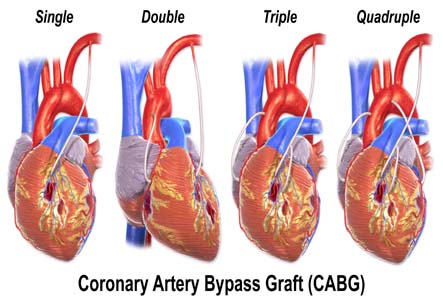Coronary Artery Bypass
Introduction
Coronary artery bypass is a surgical procedure performed to create a new route, called as bypass, for blood and oxygen to reach the heart. Both the coronary arteries are small blood vessels supplying the heart with oxygen and nutrients present in the blood. When there is partial or complete blockage of one or more branches of these arteries by fatty plaques, the heart does not get enough blood to support the metabolism. This is called as ischemic heart disease (IHD) or coronary artery disease (CAD). And the group of symptoms of this disease is called as angina in which the main symptom is chest pain. Prior to the decision of surgery, other modalities like medical treatment as well as cardiac rehabilitation or coronary angioplasty are tried.
Pre-surgery:
1. A proper history, examination and few lab tests and scans are done to determine the general health. Also, ECG and 2D echocardiography are done.
2. A coronary angiography is the procedure done to diagnose coronary artery disease. The procedure is based on results of this test.
3. Patient should stop anti-inflammatory drugs like aspirin at least 2 weeks before surgery. They can increase the bleeding during surgery.
Iran is among the top 10 countries in treating cardiovascular diseases, while it ranks first in the Middle East

4. Essential medications being taken for other conditions like diabetes, heart disease, blood pressure should be continued with advice from the treating doctor as well as cardiologist.
5. History of smoking or alcohol drinking should be told to the surgeon. Smoking should be stopped if possible as it interferes with the wound healing.
6. Recent history of cough, cold, fever, viral infections, or other illnesses should be informed to the surgeon.
7. Patient is not allowed to eat or drink anything at least 8 to 12 hours before surgery except essential medicines with sips of water.
Procedure:
1. The heart bypass is done under general anesthesia.
2. An incision is taken of about 8 to 10” in the middle of the chest and the breastbone is retracted. This is called as sternotomy. It allows the surgeon to view the heart, aorta and major blood vessels around the heart.
3. Then mostly the patient is connected to a heart lung machine. The heart is stopped. This machine does the work of breathing and circulation of blood till the surgeon works on the heart.
4. A new approach to this surgery does not use the heart lung machine. The heart is beating throughout the bypass. This is called as off-pump coronary artery bypass. This procedure is used when there are problems in surgery with patient on the heart-lung machine.
5. The surgeon takes a vein from other part of the body and is grafted around the blocked area to restore the reduced blood flow to the heart from a diseased coronary artery.
6. The surgeon can use a vein from the leg called as saphenous vein. First it is separated by an incision on the medial side of the leg from groin to the ankle. This graft vein is connected to an opening made in the aorta and the other end is connected to the coronary artery.
7. Another vessel known as internal mammary artery can also be used as a graft. This is a graft from the chest itself. Other arteries like radial artery of the wrist are also commonly used.
8. The sternotomy is closed with a wire which remains in the chest. The surgical incision is closed with stitches.
9. The entire surgery takes 4 to 6 hours. After reversal of anesthesia, the patient is transferred to an intensive care unit.
Risks for surgery include:
1. Blood clots in the legs travelling to the lungs
2. Medication allergy
3. Breathing problems
4. Infection of lungs, urinary tract or chest
5. Blood loss
Possible risks from of coronary bypass surgery are:
1. Surgical wound infection especially in obese, diabetic or repeat surgery patients.
2. Heart attack or stroke
3. Arrhythmias
4. Kidney failure
5. Memory loss or loss of mental clarity
6. Chest pain and low fever also called as post-pericardiotomy syndrome. The symptoms can persist for about 6 months.
After the Procedure:
1. The total hospital stay after the coronary artery bypass is about 3 to 7 days. Patient is shifted to an intensive care unit (ICU) for 1 or 2 days immediately after the surgery.
2. Two to three chest tubes are present to drain the blood or fluid after surgery. These are usually removed in 1 to 3 days.
3. A urine catheter is present in the bladder. 2 or 3 intravenous lines are also there to infuse fluids and drugs. The patient is monitored closely for blood pressure, oxygen saturation and heart rate changes.
A cardiac rehabilitation program is started within a few days. 4 to 6 weeks are required to feel better. Complete recovery from the heart bypass surgery takes 3 to 6 months. The graft usually remains patent and is functional for many years.